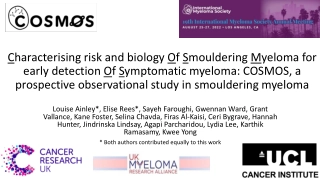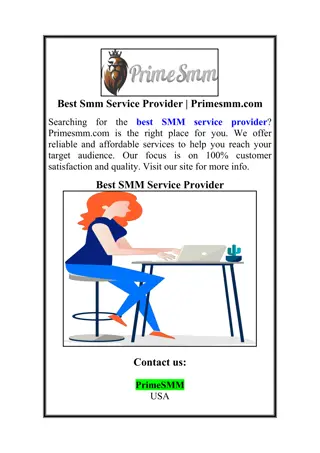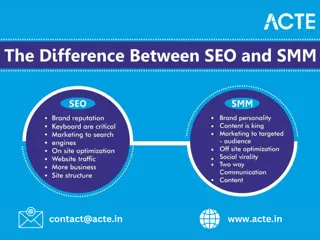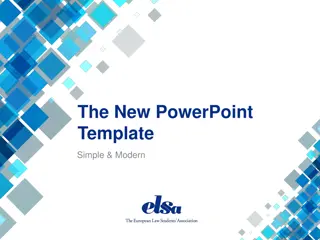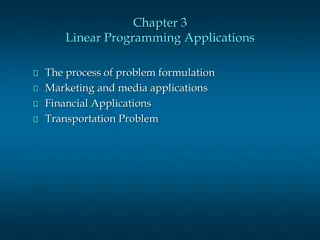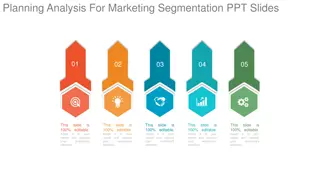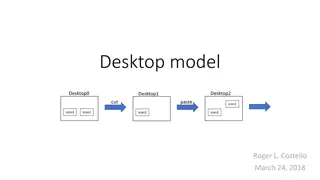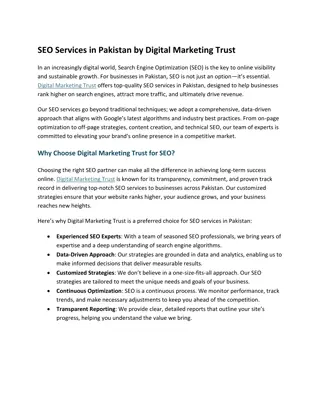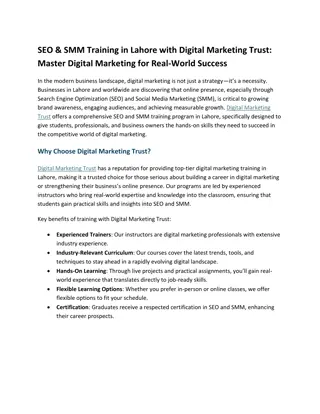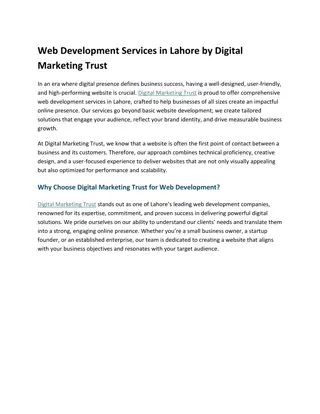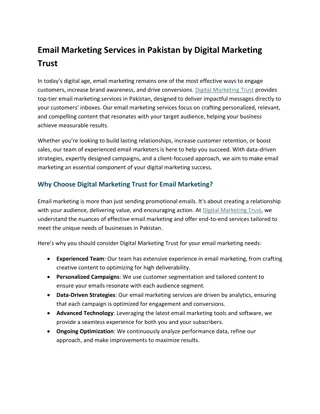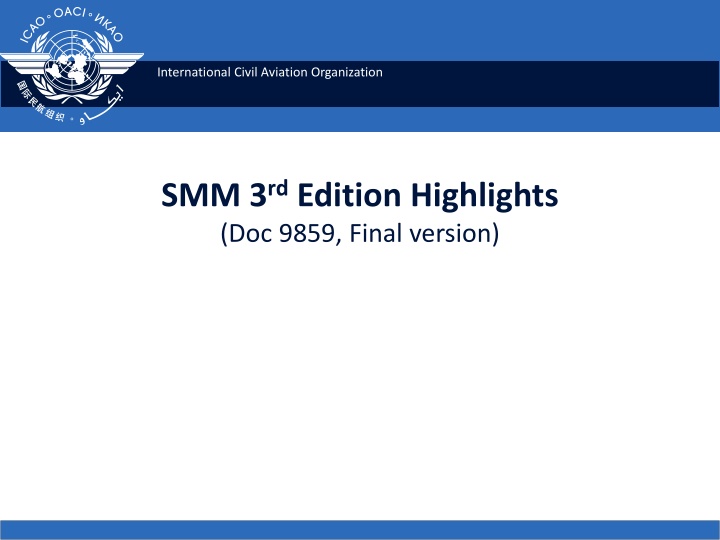
Key Highlights of International Civil Aviation Organization SMM 3rd Edition
Explore the key highlights of the International Civil Aviation Organization SMM 3rd Edition, covering safety management fundamentals, SARPs, state safety programs, and safety management systems. Learn about definitions, safety culture, hazards prioritization, safety risk management, and performance-based requirements outlined in this comprehensive edition.
Download Presentation

Please find below an Image/Link to download the presentation.
The content on the website is provided AS IS for your information and personal use only. It may not be sold, licensed, or shared on other websites without obtaining consent from the author. If you encounter any issues during the download, it is possible that the publisher has removed the file from their server.
You are allowed to download the files provided on this website for personal or commercial use, subject to the condition that they are used lawfully. All files are the property of their respective owners.
The content on the website is provided AS IS for your information and personal use only. It may not be sold, licensed, or shared on other websites without obtaining consent from the author.
E N D
Presentation Transcript
International Civil Aviation Organization SMM 3rdEdition Highlights (Doc 9859, Final version)
SMM 3rd Edition Highlights - Agenda 1. Introduction 2. SMM 3rd Edition - Contents overview 3. Twenty-six enhancements 4. Summary 5. Q & A Project title (Insert, Header & Footer) 2
SMM 3rd Edition - Introduction SMM 1st & 2nd editions in 2006 & 2009 SMM 3rd edition (advance version) posted on 28 May 2012 SMM 3rd edition final (en) version posted on 8 May 2013 Purpose of this presentation Project title (Insert, Header & Footer) 3
SMM 3rd Edition Contents overview 4 Chapters: CHAPTER 1 - SAFETY MANAGEMENT FUNDAMENTALS CHAPTER 2 - ICAO SAFETY MANAGEMENT SARPs CHAPTER 3 - STATE SAFETY PROGRAMME (SSP) CHAPTER 4 - SAFETY MANAGEMENT SYSTEM (SMS) (previous SMM 2nd Edition 2009 had 11 Chapters) Browse SMM 3rd Edition Contents Page Project title (Insert, Header & Footer) 4
Chapter 1 Highlights: (5) Safety Management Fundamentals 1. Definitions: List of Definitions included(new) [DEFNS] 2. Safety Culture [2.6]: Organization risk profile assessment (new)[C1A3] Project title (Insert, Header & Footer) 5
Chapter 1 Highlights: (5 of 5) Safety Management Fundamentals 3. Hazards [2.13]: Hazards prioritization procedure(new)[C1A1] Distinguishing Aviation & OSHE hazards (new) 4. Safety Risk Management (SA) [2.15]: Basic risk mitigation tool (enhancement) 5. Prescriptive & Performance-based Requirements [2.16] Performance-based requirements and its oversight Project title (Insert, Header & Footer) 6
Chapter 2 Highlights: (2) Safety Management SARPs 1. SARPs [chpt 3]: Consolidation and overview of current safety management SARPs (new) 2. Annex 19 [3.4]: Introduction to Annex 19 development status (new) Project title (Insert, Header & Footer) 7
Chapter 3 Highlights: (1 of 6) State Safety Programme 1. SSP framework elements overall guidance improvements: Enforcement Policy (1.4) [C4, App 10 & 11]: Clarity between enforcement policy & enforcement procedures(enhancement) Agreement on service provider safety performance (2.2) Agreement on SPIs and associated target & alert settings (enhancement) Project title (Insert, Header & Footer) 8
Chapter 3 Highlights: (1 of 6) continued State Safety Programme Safety data collection, analysis and exchange (3.2) [C4- App 2, 3 & 5]: Mandatory & voluntary reporting systems(new); Safety information protection (enhancement) Safety-data driven targeting of oversight on areas of greater concern or need (3.3) [C4- Fig 4-1]: Safety data and risk based surveillance process (enhancement) [Fig 4-1] Project title (Insert, Header & Footer) 9
Chapter 3 Highlights: (2 of 6) State Safety Programme 2. SSP Gap Analysis & Implementation Plan [4.3.3; App 7] Updated gap analysis questions, including main text references (enhancement) [C4-App7] Improved documentation for gap analysis outcomes and tasks implementation (new) [T4-A7-2&3] Project title (Insert, Header & Footer) 10
Chapter 3 Highlights: (3 of 6) State Safety Programme 3. SSP Implementation Phased Approach [5.5; Table A] Guidance on 4-phased progressive implementation of SSP elements & processes (new) [C4-T4-1] Project title (Insert, Header & Footer) 11
Chapter 3 Highlights: (4 of 6) State Safety Programme 4. Safety Indicators & Acceptable level of safety performance (ALoSP) [4.3.5; App 4] Guidance on ALoSP measurement and monitoring through State aggregate SPIs and associated Target and Alert levels (new) [C4-App4] In essence - A State defines its ALoSP through: A selected package of aggregate SPIs; Set Target and Alert levels for each SPI; and Monitor & measure individual & consolidated SPIs Target achievement & Alert avoidance (Yes/ No) outcomes. Project title (Insert, Header & Footer) 12
Chapter 3 Highlights: (4 of 6) State Safety Programme SPI Alert & Target settings and a State s ALoSP: An Alert level ensures attention is drawn to a SPI anytime its trending is statistically worse off than its recent performance A Target level ensures a planned endeavor to drive a SPI to improve on its own recent average performance Alert exceedance & Target achievement incidence count is a data-based performance measure of a package of SPIs - hence the expression and measure of a State s ALoSP Project title (Insert, Header & Footer) 13
Chapter 3 Highlights: (6 of 6) State Safety Programme 5. SMS Acceptance/ Assessment [App 7] Initial SMS regulatory acceptance as well as routine SMS audit checklists (new) [C4-App 12] 6. SSP Document/ Manual Contents[C4-App 8] Guidance on SSP Manual Contents development (new) Project title (Insert, Header & Footer) 14
Chapter 4 Highlights: (4) Safety Management System 1. SMS framework elements overall guidance improvements: Emergency Response Planning (1.4) [C5-App 3] Enhanced guidance on emergency response planning (enhancement) SMS Documentation (1.5) [C5-App 4] Guidance on development of a SMS Document/ Manual (new) Project title (Insert, Header & Footer) 15
Chapter 4 Highlights: (4) Safety Management System Hazard Identification (2.1) [C5-App 5] Guidance on SMS voluntary and confidential reporting system (new) Risk Assessment & Mitigation (2.2) [C2-App 2] Basic Safety Assessment Tool (new) [C2- App 2] Latest version> Project title (Insert, Header & Footer) 16
Chapter 4 Highlights: (4) Safety Management System 2. Integration of Management Systems [2.9; 5.4.2] Enhanced guidance, especially on SMS-QMS integration (enhancement) 3. SMS Gap Analysis & Implementation Plan [5.4.3/4; App7] Updated gap analysis questions, including main text references (enhancement) Project title (Insert, Header & Footer) 17
Chapter 4 Highlights: (4) Safety Management System 4. SMS Safety Indicators & Safety Performance [5.4.5; App 6] Safety performance measurement through SPIs target and alert settings Project title (Insert, Header & Footer) 18
SMM 3rd Edition Highlights - Summary 1. List of Definitions Chapter 1 (Safety Management Fundamentals): 2. Organization risk profile assessment 3. Hazards prioritization procedure 4. Distinguishing Aviation & OSHE hazards 5. Basic risk mitigation tool 6. Performance-based requirements and its oversight Chapter 2 (Safety Management SARPs): 8. Consolidation of current safety management SARPs 9. Introduction to Annex 19 development status Project title (Insert, Header & Footer) 19
SMM 3rd Edition Highlights - Summary Chapter 3 (State Safety Program): 10. Clarity between enforcement policy & procedures 11. Agreement on SPIs, Targets & Alert settings 12. Mandatory & voluntary reporting systems 13. SPI & ALoS development 14. Safety information protection 15. Safety data and risk based surveillance process 16. Updated GAQs, including main text references 17. Documentation for gap analysis & tasks implementation 18. 4-phased progressive implementation of SSP 19. ALoSP measurement through SPI Target and Alert levels Project title (Insert, Header & Footer) 20
SMM 3rd Edition Highlights - Summary Chapter 4 (SMS): 20. Guidance on emergency response planning 21. Guidance on development of a SMS Document/ Manual 22. Guidance on SMS voluntary reporting system 23. Basic Safety Assessment Tool 24. SMS-QMS integration guidance 25. Updated GAQs, including main text references 26. Safety performance measurement through SPI target and alert settings Project title (Insert, Header & Footer) 21
SMM 3rd Edition Q & A Project title (Insert, Header & Footer) 22

